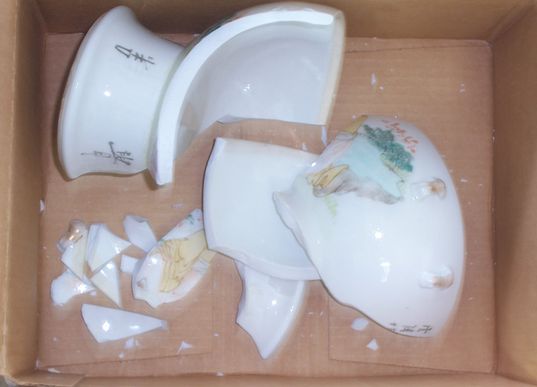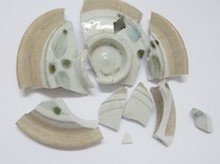Porcelain Repair & Restoration
A porcelain repair or restoration is something you may face earlier or
later if you are handling lots of antique porcelain or pottery.

This high-foot bowl was broken due to improper packaging.
|
Unless you are always extremely careful a piece may knock a hard object or another porcelain item, and crack or break. It happens to all of us...
|
Special glues are required for professional porcelain repair, and worldwide there may only exist a handful or so different glues suitable for this specialized purpose. They are very expensive. Those glues at your hardware store that it says can be used for gluing porcelain or ceramics is not one of these!
Avoid gluing porcelain with any glue sold at your local hardware store, it may not be suitable. These glues often will turn yellow after some time even if they are transparent at the beginning, and they may not be thin enough for the job.
|
The broken lid of the 19th century medicine jar shown on the right is the result of careless handling. |
 |
The cleaning process may take quite some time as the pieces may have to
be immersed in cleaning water for some time, and after cleaning they
need to be left to completely dry for many days. In case of pottery the
drying time is even longer. A repair can only begin after all pieces are
dry.
A restoration complete with cleaning, repair, filling, and re-painting
will usually take a couple of weeks, at least, often a month or two to
complete.
|
|
Restoration
There are three types of restoration.
- Commercial restoration
- Museum restoration
- Research restoration
Of the above three a commercial restoration is the most demanding. The
purpose of this is to restore the look of a piece as nearly as possible
to its original state. Such a restoration may be hardly or not at all
visible. Aesthetic value is the most important. The decoration and
glaze will be restored and sometimes a low temperature firing performed.
Porcelain restored this way will usually be for sale, or for a private
collection.
A museum restoration is for the purpose of display. Usually, any mended
places remain visible and there is a requirement of reversibility of the
restoration.
Restorations for research have the least requirements due to their
purpose, which is mainly to establish the look, shape or use of an item.
Handling Ceramics Safely
Chinese Porcelain Home Page
Go from Porcelain Repair to Antique Mark Removed
